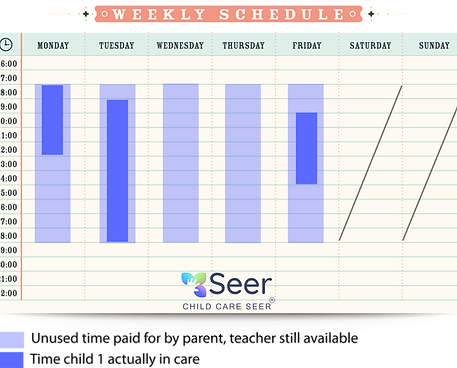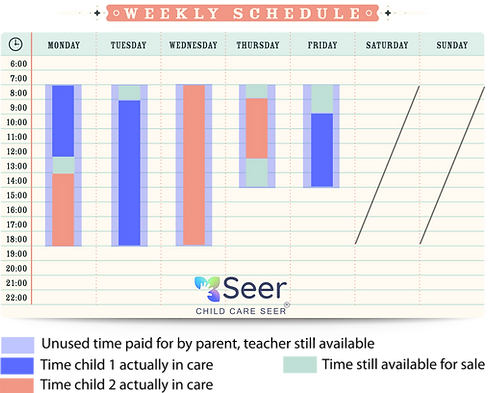Why parents will pay you more per hour when you offer the hours they need?
Convenience is a product that has immense value to your customers.
A parent who only needs 20 hours of care per week would gladly pay a higher rate per hour for those 20 hours, rather than a lower rate for 50 hours they can’t fully use.
Child Care Seer is the ONLY tool available that removes all of the headaches with
offering this kind of high demand
flexible care.

In a year-long study we conducted in our own centers, 46% of Parents who started their children in flexible care increased their usage over time & eventually switched to higher revenue full-time programs. This resulted in an average revenue increase of 1.9% per week.
WIN, WIN, WIN Scenario
In this scenario we find a Win/Win/Win outcome as two Families now save $80 per week (WIN) and don’t pay weekly for something they need hourly! Teachers can get paid $2.25 more per hour by taking the unused hours away and giving them more planning time(WIN), and the daycare makes an extra $40 (WIN).
Let’s look at the math in an example to explain why parents would be willing to pay more per hour of care. The scenario below creates a bigger increase to your revenue per hour of care.
Standard
Daycare

-
Full-time Care = $200 ($4 /hr x 50 hours)
-
They only used 20 of the 50 available hours
-
Fixed labor cost = $60 (Fixed labor cost per “slot”
-
for 50 hours of 3 year old care @$12 per hour.
-
50*12/10=60)
-
Daycare earns $140 ($200 - $60 = $140)
Daycare Offering Flexible
Care to multiple Families

-
Offer a 20 hr/week plan for $120 ($6 /hr x 20 hrs)
-
Offer the available space to another family
-
With same labor cost = $60
-
Teacher making more per hour (~$14.25 per hour)
-
Teacher required for fewer hours (-8 hrs)
-
Daycare now earns $180 ($240 - $60 = $180)
For example, if you typically charge $200 per week for a full-time slot (50 hours of possible care), the parent is paying $4 per hour as shown in “standard daycare” illustration below. Most families appreciate that with a bit of communication and the right tools on the expected schedule they can pay $6 per hour for the 20 hours they really want to use instead of paying for 30 hours they aren’t using. When combined with other families’ needs, for example another family wanting 20 hours at different times, the daycare is able to make $240 for the entire full-time slot, and each family has
a weekly bill of only $120 as shown in “flexible care” illustration below. Customer satisfaction is dramatically increased and you have an offering that stands out from the competition. By generating more revenue from fewer hours (42 versus 50), the daycare incurs lower costs
to serve these families and thus boosts its profits. This is the win/win/win scenario that is possible when you adopt this philosophy and have a tool like Child Care Seer making it easy. The more you know about when customers need you, the better you can tailor your offering to meet their needs—and increase your profits.

